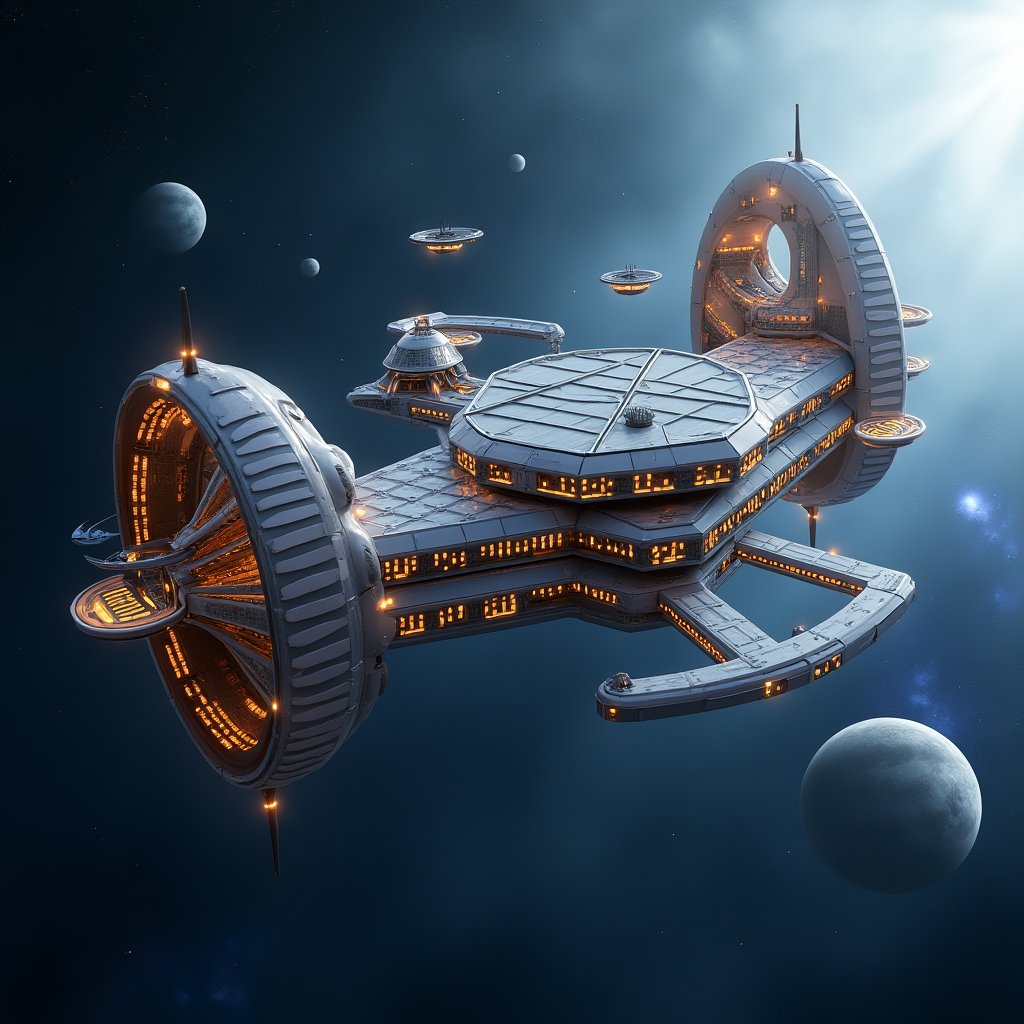The golden age of space exploration is no longer a fantasy—it’s unfolding before our eyes. Private space industries are booming, NASA is eyeing permanent lunar outposts, and Elon Musk’s SpaceX is racing toward Mars. But here’s the million-dollar question: How do we actually build sustainable, long-term habitats in space? The answer may not lie in the hands of human engineers alone, but in artificial intelligence (AI). Yes, AI isn’t just disrupting industries on Earth—it’s about to redefine how we survive in the vast emptiness beyond our planet.
Many have pondered what it takes to live among the stars. The legendary Isaac Asimov explored AI-driven space habitats in his works, envisioning artificially managed colonies governed by logic and efficiency. More recently, Michio Kaku has frequently discussed the role of automation and robotics in making deep-space habitats viable. Even Elon Musk himself has emphasized that AI will play a pivotal role in the colonization of Mars. The common thread? AI isn’t just a tool—it’s the architect, the caretaker, and the key to unlocking our extraterrestrial future.
Unlike traditional space station designs that require constant human maintenance, AI-powered habitats could be self-sufficient, adjusting their structures, life-support systems, and even social governance in real-time. These space habitats wouldn’t be static constructs but evolving ecosystems that adapt alongside their inhabitants. From AI-optimized modular structures to self-repairing materials engineered at the atomic level, the future of human space habitation is moving toward complete autonomy.
In this piece, we’ll explore how AI is shaping the architecture, sustainability, and functionality of future space stations. More than just floating labs or research outposts, these AI-designed marvels could allow humanity not just to visit space, but to truly live there.
1. AI-Driven Architecture and Modular Design for Space Stations
The construction of space stations has always been a logistical nightmare. Traditional space habitats like the International Space Station (ISS) required decades of assembly, hundreds of space missions, and continuous human presence for maintenance. But what if space stations could build themselves, evolve dynamically, and be tailored to the needs of their inhabitants? Enter AI-driven modular design—a game-changer in extraterrestrial architecture.
1.1 How AI Designs Modular Space Habitats
Designing a space station isn’t just about putting together metallic tubes in orbit. It’s about creating a structure that can withstand extreme radiation, fluctuating temperatures, and sudden micro-meteoroid impacts—all while supporting human life. AI can handle these challenges far better than humans, thanks to its ability to analyze complex variables simultaneously.
- Generative design algorithms: AI uses massive datasets from satellites, planetary scans, and past missions to generate optimal architecture layouts. By simulating potential hazards like dust storms on Mars or violent solar flares in deep space, AI can craft modular habitats that are built for survival.
- Dynamic adaptation: Unlike rigid designs of the past, AI-driven modules can evolve. If a section of the space station becomes damaged or obsolete, AI can assess the situation and reconfigure the station in real time.
- Prefab and 3D printing in space: AI doesn’t just plan—it prints. With advancements in autonomous 3D printing, space habitats can be built using in-situ materials, reducing dependency on Earth for construction supplies.
1.2 The Benefits of Modular Construction in Space
Imagine starting with a small, self-sustaining complex in lunar orbit. Over time, additional modules attach like LEGO pieces, forming an entire city in space. This is where modular design shines, and AI ensures the process remains efficient and sustainable.
- Scalability: Unlike traditional space stations that require massive planning before deployment, modular habitats can expand based on need. Whether the crew size increases or scientific operations diversify, AI-managed modules can be added seamlessly.
- Efficient resource allocation: AI-driven architectures don’t just create living spaces; they actively manage energy distribution, thermal control, and waste recycling. Every module is optimized for exactly what it needs, reducing inefficiencies.
- Reconfigurability: Need to relocate a segment of the station closer to a new resource hub? AI can coordinate modular relocations autonomously, reassembling stations to meet mission-specific goals.
Modular AI-designed stations aren’t just a concept—they’re already being tested. NASA’s Lunar Gateway will incorporate AI-managed modular design, proving that this approach is more than just theoretical. If successful, future Mars stations will follow this blueprint, allowing human settlements to grow organically over time.
By merging AI with modular construction, space habitats will shift from being expensive, fragile constructs to adaptive, resilient, and self-sustaining ecosystems. With AI at the helm, extraterrestrial living moves from the realm of imagination into tangible reality.
2. AI-Optimized Life Support and Sustainability
One of the most critical challenges of long-term space habitation is ensuring a stable, self-sufficient ecosystem. Traditional human-controlled systems have limitations, requiring frequent adjustments and maintenance. However, artificial intelligence (AI) is revolutionizing life support by creating autonomous, self-correcting environmental systems that optimize resources in real-time. Could AI-managed life support systems be the key to independence from Earth?
2.1 Autonomous Life Support Systems
In space, every drop of water, every breath of oxygen, and every calorie consumed must be carefully managed. AI-driven life support systems are evolving to orchestrate these elements with unmatched efficiency.
- AI-managed oxygen production: By analyzing crew activity levels and atmospheric conditions, AI can regulate oxygen output, reducing energy waste while ensuring safe breathing levels.
- Water recycling systems: Advanced AI filters and purifiers optimize water reclamation from respiration, sweat, and waste processes, ensuring a sustainable water cycle.
- Hydroponic and aeroponic farming optimization: NASA has already experimented with aeroponic farming methods on the ISS. AI can elevate this further by fine-tuning nutrient delivery to maximize food production efficiently.
- Climate control and environmental adjustment: AI algorithms track temperature, humidity, and atmospheric composition, adjusting the habitat to maintain a comfortable and healthy living space.
- Robotic maintenance: AI-driven robotic caretakers handle the labor-intensive task of repairing and maintaining life-support systems, reducing the need for human intervention.
2.2 Sustainable Energy and Resource Efficiency
Energy in space is a precious resource. AI ensures space stations maximize efficiency while reducing waste.
- AI-optimized solar power management: Machine learning algorithms predict energy demands and adjust solar panel angles dynamically for maximum light capture.
- Storage and distribution: AI forecasts energy needs, distributing stored power during peak demand periods to avoid downtime.
- Atmospheric regulation: Carbon dioxide scrubbers fine-tuned by AI ensure a delicate balance between oxygen generation and CO₂ removal, preventing toxicity.
- Smart waste recycling: Every gram of matter is vital in space. AI-powered waste processors transform organic materials into usable biocompost, water, and construction materials.
By optimizing energy consumption and resource recycling, AI plays a crucial role in transforming space habitats into self-sustaining environments, accelerating the goal of human independence from Earth.
3. AI-Guided Self-Repairing Infrastructure and Robotics
In the unforgiving vacuum of space, infrastructure failure can be catastrophic. Unlike on Earth, where repairs can often be handled by a technician within hours, astronauts on distant space stations may have limited or no access to outside help. AI-driven self-repairing materials and maintenance robotics are revolutionizing space architecture.
3.1 Self-Healing Materials and Smart Coatings
Traditional spacecraft require meticulous external inspections for cracks or damage from micrometeorites and radiation exposure. AI-integrated smart materials are changing that by enabling automated self-repair.
- Self-healing polymers: Scientists at institutions like Caltech have been developing materials that autonomously reseal microscopic damage upon impact.
- Smart coatings: AI-powered nanocoatings adjust to temperature fluctuations, increasing insulation efficiency and minimizing mechanical stress.
- Radiation-reactive materials: AI-controlled adaptive shielding dynamically counters radiation exposure by thickening high-impact areas in real time.
- On-demand 3D printed components: AI-integrated 3D printing systems can manufacture spare parts from raw materials on-site, eliminating downtime due to damaged components.
3.2 Robotic Maintenance and AI-Driven Diagnostics
The combination of robotics and AI is allowing for predictive maintenance—an approach where problems are detected and fixed long before they cause system failure.
- Autonomous inspection drones: AI-powered drones patrol space stations, scanning the hull for microfractures invisible to the human eye.
- Robotic limbs and repair systems: Inspired by the Canadarm on the International Space Station, future AI-assisted robotic arms could perform tasks like welding and replacing panels autonomously.
- Predictive maintenance AI: By analyzing sensor data, AI can generate real-time risk assessments, predicting malfunctions before they occur.
These advancements ensure space stations remain operational with minimal human manual labor—key for deep-space missions where survival depends on fully autonomous systems.
4. AI-Enhanced Human Adaptation and Psychological Well-Being
Long-term space habitation is about more than just surviving in a metal box floating through the void. The psychological toll of deep space missions has been a major challenge for astronauts, even in relatively short stays aboard the International Space Station (ISS). Imagine life in space not for months but decades—or even lifetimes. AI-driven systems could be the key to ensuring not just survival but a meaningful existence beyond Earth.
4.1 AI’s Role in Human Health Monitoring
Space travel is brutal on the human body. The lack of gravity affects muscle and bone density, radiation damages cells, and the confined environment can cause both physical and psychological stress. AI-driven health monitoring could revolutionize space medicine by anticipating and addressing health concerns before they become life-threatening.
- Biometric tracking: Wearable AI-powered devices would continuously monitor astronauts' vitals—heart rate, muscle atrophy, hydration levels, and even stress indicators—allowing for real-time adjustments in diet, exercise, and medical treatment.
- Automated diagnostics: AI algorithms, fed with vast datasets of medical knowledge, could diagnose conditions faster and more accurately than human doctors, reducing reliance on Earth-based medical staff.
- Smart exercise regimens: AI-adaptive fitness programs could adjust resistance, duration, and type of exercise based on biomarkers to mitigate muscle and bone loss in microgravity.
- Telemedicine and robotic surgery: AI-assisted robotic surgery could allow spacefarers to perform life-saving procedures under the guidance of Earth-based specialists.
4.2 Psychological Well-Being and Social Dynamics
Being trapped in a confined space with the same people for years is a psychological experiment in itself. AI-driven systems could help mitigate the mental health challenges associated with isolation and monotony.
- Virtual environments: AI-powered VR simulations could replicate Earth-like conditions—forests, cities, oceans—to provide astronauts with a sense of escape.
- AI-driven social monitoring: Machine learning can analyze speech patterns and behavior to detect early signs of stress, anxiety, or depression, prompting intervention strategies.
- AI-mediated conflict resolution: In confined quarters, social tensions can run high. AI-driven communication analysis could provide conflict resolution suggestions or mediate discussions.
The success of AI-assisted mental health strategies could make the difference between a thriving space civilization and one plagued by psychological breakdowns. Could AI even become a therapist for deep-space settlers, guiding them through the emotional challenges of extraterrestrial life?
5. AI-Powered Autonomy and Decision-Making in Space Stations
In the vast distances of space, waiting for Earth’s command center to provide instructions in an emergency could mean the difference between life and death. Future space civilizations will need autonomous AI-controlled stations capable of making split-second decisions and managing vital systems independently.
5.1 AI as Command and Control for Space Stations
Imagine a space station governed not by human mission control but by a sophisticated AI capable of overseeing every operational detail. AI’s ability to process vast amounts of data, predict outcomes, and make optimal adjustments in real-time makes it the perfect candidate for running an autonomous extraterrestrial base.
| AI-Controlled System | Function |
|---|---|
| Power Management | Optimizes solar panel orientation, energy distribution, and reserves in response to usage patterns. |
| Life Support | Monitors oxygen levels, CO₂, temperature, and water supply, autonomously adjusting for efficiency. |
| Emergency Handling | Immediately detects depressurization, fires, or system failures and executes emergency protocols. |
| Mission Planning | Allocates resources for experiments, power consumption, and crew schedules based on mission objectives. |
With AI taking on these responsibilities, human settlers would be free to focus on exploration, innovation, and, perhaps, the sheer wonder of living among the stars.
5.2 AI-Dominated Space Governance and Ethics
Could AI go beyond logistics and enter the realm of governance? With space colonies forming the first extraterrestrial societies, AI may be called upon to balance economics, productivity, medical priorities, and social order. The ethical implications are complex:
- Resource Allocation – In a closed loop ecosystem, AI would need to fairly distribute food, water, and energy, optimizing for sustainability and human well-being.
- Law Enforcement – If a crime or dispute arises on a space station, could AI act as an impartial judge handling case evidence and conflict resolution?
- Autonomy vs. Human Oversight – How much control should AI have? Should humans always have the final say, or will AI-evaluated solutions prove more optimal and unbiased?
- Ethical Programming – AI requires a foundational code of ethics. But who decides these ethical parameters—Earth’s governments, space-based communities, or an international coalition?
If AI governs settlements far from Earth’s influence, could it introduce a new form of AI-run democracy? While the idea calls to mind dystopian fears of authoritarian machine rule, it also presents an opportunity for streamlined, bias-free governance where all decisions are logically justified.
The autonomy of AI-powered space habitats could mark the birth of a truly self-sustaining interstellar civilization, but humanity must first answer a question as ancient as governance itself: How much control should we relinquish to the machines we create?
6. The Future of AI-Designed Space Stations and Interplanetary Expansion
As artificial intelligence continues to evolve, its influence on space station design and extraterrestrial habitation will be nothing short of revolutionary. No longer static structures, these AI-optimized habitats represent the first steps toward human expansion beyond Earth's orbit, paving the way for sustainable, long-term space colonization. But the question remains—will these AI-driven designs remain confined to Earth’s orbit, or could they become the backbone of a multi-planetary civilization?
6.1 AI in Terraforming and Planetary Settlements
The idea of terraforming planets like Mars used to be purely speculative, a dream for futurists and sci-fi enthusiasts. However, AI is beginning to make elements of this vision feasible. Machine learning algorithms can analyze vast amounts of planetary data, predicting the best locations for human settlement by assessing atmospheric composition, geologic stability, and access to essential resources like water and sunlight.
- Climate Control and Atmospheric Engineering: AI-powered simulations could chart out the most efficient paths for planetary terraforming, from introducing engineered bacteria that produce oxygen to designing closed-loop climate regulation systems.
- Site Selection and Habitat Optimization: Robotic probes driven by AI can scout and select the best regions to establish colonies based on resource distribution, while AI-optimized models can generate dynamic city layouts that evolve according to environmental changes.
- Self-Replicating Autonomous Machines: AI-powered robotic systems could build infrastructure independently. These machines, equipped with 3D-printing capabilities using local resources, could construct entire settlements before human arrival.
Organizations like NASA, SpaceX, and Blue Origin are investing in autonomous robotics and AI-driven research to support off-world infrastructure development. In the coming decades, entirely AI-fabricated habitats might be waiting for settlers upon their arrival.
6.2 Are AI-Designed Space Habitats the First Step Toward an Interplanetary Civilization?
If AI-designed space habitats become the norm, this could be humanity’s stepping-stone toward an interstellar civilization. Space stations strategically placed between planets could serve as waypoints, hotels, research hubs, and fueling stations—transforming our solar system into a highway of human activity.
Here’s what an AI-managed interplanetary infrastructure might look like:
- Martian Mega-Cities: AI-driven systems construct entire cities beneath radiation-proof domes, sustaining an Earth-like ecosystem while ensuring minimal human maintenance.
- Orbiting Space Metropolises: Floating AI-designed habitats (akin to O’Neill Cylinders) provide fully self-sustaining space colonies independent of planetary surfaces.
- AI-Governed Trade Routes: Space cargo operations managed by autonomous AI ensure efficient supply chains between Earth, the Moon, and Mars.
- Deep Space Exploration Hubs: AI-powered research installations on Europa or Titan analyze exoplanetary ecosystems, hunting for signs of microbial extraterrestrial life.
The ambitions of AI-designed space stations don’t just offer a vision of distant colonies—they represent the seeds of an entirely new civilization. If AI can construct habitable zones across our solar system, interplanetary expansion isn’t just an option—it’s inevitable.
The New Frontier of AI-Driven Space Habitats
AI-designed space stations are more than just futuristic concepts—they are the stepping stones to a new era of space colonization. By leveraging AI in architecture, habitat sustainability, self-repairing materials, and life-support systems, humanity is gradually laying the foundation for sustainable extraterrestrial living.
But this AI-driven future also presents challenges. While AI can optimize structures and systems far beyond human capabilities, do we risk over-reliance on automated decision-making? Could a malfunction or unforeseen AI decision endanger entire human settlements? Governance models must balance the benefits of automation with necessary human oversight, ensuring that AI serves as a tool rather than an unchecked ruler.
Ethical dilemmas also abound. Who owns an AI-designed space station? Should access to off-world settlements be restricted to certain nations or corporations? And if AI successfully builds the first space colonies, does this solidify artificial intelligence as the architect of humanity’s destiny?
All signs point toward a new frontier—a world where AI ushers in the next phase of evolution, using data, optimization, and decision-making to help humanity expand beyond the confines of Earth. Whether we embrace it or fear it, the AI era of space exploration has already begun. The only question left is: Are we ready to trust AI with humanity’s future beyond the cosmos?
What do you think? Would you feel comfortable living in an AI-designed space station? Could AI go beyond designing habitats and actually govern space colonies? Let us know your thoughts in the comments below!
Don’t miss out on the latest insights into space exploration, AI, and future technology. Subscribe to our newsletter, join the debate, and become a resident of iNthacity: the "Shining City on the Web."
Frequently Asked Questions (FAQ) About AI-Designed Space Stations
What role does AI play in designing space stations?
Artificial Intelligence is revolutionizing space station construction by utilizing machine learning and generative design algorithms to create habitats that dynamically adapt to extraterrestrial environments. Traditional engineering methods rely on static blueprints and extensive human oversight, whereas AI can simulate thousands of design iterations in mere moments, optimizing for radiation exposure, temperature fluctuations, and available materials.
How do AI-driven space habitats ensure long-term human survival?
Surviving in space isn’t just about having oxygen—it’s about creating a self-sustaining ecosystem. AI-driven habitats regulate life-support systems autonomously, balancing oxygen levels, food production, and waste management with minimal human intervention. AI achieves this by:
- Continuously monitoring environmental conditions and adjusting in real-time.
- Utilizing hydroponics and aquaponics for sustainable food production.
- Employing machine learning models to optimize energy consumption and water recycling.
This level of autonomy ensures that humans can survive for extended periods without resupply from Earth, making deep-space colonization feasible.
Are AI-designed space stations completely autonomous?
Not entirely—at least, not yet. While AI manages critical operations like environmental controls, maintenance, and safety protocols, human oversight remains crucial. AI currently functions as an advanced managerial system rather than a full-fledged autonomous ruler. Think of it as similar to NASA’s autonomous spacecraft—it can operate independently but still relies on human input for overarching decisions.
What materials are used in AI-driven space station construction?
A combination of carbon fiber, titanium alloys, and regolith-based materials is used to maximize durability and energy efficiency. Self-healing materials, such as polymers embedded with microcapsules filled with healing agents, can autonomously repair minor damages caused by micrometeoroids.
Could AI help terraform planets for future human colonies?
Yes! AI is already being used in climate simulations and environmental modeling on Earth, and these same technologies are being adapted for interplanetary applications. Terraforming—altering a planet’s atmosphere and surface conditions to support human life—requires immense data analysis, something AI excels at. Potential AI applications for terraforming include:
| Terraforming Task | AI's Role |
|---|---|
| Atmospheric Engineering | AI models predict climate impact and manage greenhouse gas balance. |
| Automated Biosphere Development | AI-controlled systems regulate plant growth within artificial habitats. |
| Water Resource Management | AI oversees ice mining and liquid water distribution. |
These innovations bring us one step closer to making environments like Mars not just visitable, but livable.
Can AI space stations repair themselves?
Yes! AI-integrated autonomous repair systems allow space stations to fix minor and even major damages without human involvement. These include:
- AI-powered maintenance drones that inspect station integrity and repair leaks.
- Self-healing materials that seal cracks caused by micrometeoroid impacts.
- On-demand 3D printing of replacement components directly aboard the station.
This creates a truly self-sustaining space habitat where human engineers need only intervene in extreme cases.
What are the biggest risks of AI-designed space stations?
Despite their promise, AI-designed space stations face several potential risks:
- Cybersecurity Threats: An AI managing a space habitat is vulnerable to hacking or system failures.
- AI Decision Autonomy: How much control should we relinquish to AI? Ethical concerns arise over AI’s decision-making in crisis situations.
- Technical Failures: Even the best AI faces occasional malfunctions, and in deep space, this could be catastrophic.
To mitigate these risks, redundancy systems, cybersecurity protocols, and human oversight remain integral components of AI-driven space station designs.
When will AI-designed space stations become a reality?
We may see early prototypes of fully AI-managed space habitats within the next 20 to 30 years. Companies like SpaceX and governmental agencies such as ESA have already begun implementing AI-driven automation in space exploration. In the next few decades, stations more advanced than the International Space Station (ISS) could be operational, paving the way for a future where AI governs entire extraterrestrial cities.
Could AI-designed space stations lead to interstellar travel?
Possibly! AI-driven space stations are not just about near-Earth habitation but could also act as stepping stones for deep-space missions. AI-managed space habitats could serve as waystations between Earth and distant destinations like Proxima Centauri b or Jupiter’s moon Europa. While true interstellar travel is still decades, if not centuries, away, AI-designed habitats are laying the necessary groundwork for such an ambitious future.
Do you believe AI-managed space stations are the future of extraterrestrial civilization? Let us know your thoughts in the comments!
Wait! There's more...check out our gripping short story that continues the journey: The Architect of the Stars
Disclaimer: This article may contain affiliate links. If you click on these links and make a purchase, we may receive a commission at no additional cost to you. Our recommendations and reviews are always independent and objective, aiming to provide you with the best information and resources.
Get Exclusive Stories, Photos, Art & Offers - Subscribe Today!





























Post Comment
You must be logged in to post a comment.